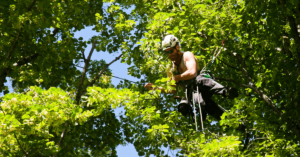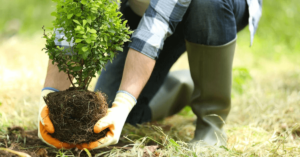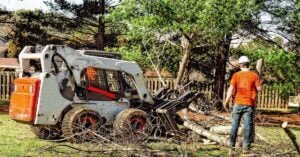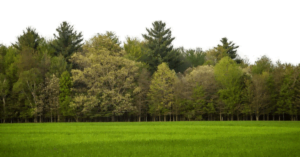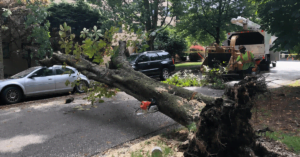What happens to a tree when it’s no longer living? Does it just stand there forever, without growing or changing? In reality, there are subtle signs that indicate when a tree is considered dead – whether the life has been taken out of old age or in an unexpected natural disaster.
As much as we nurture and care for these majestic creatures, they will eventually pass away and taking notice of those small changes can help us understand our environment better. Join me in this blog post as we explore what ultimately makes a tree die and how you should go about monitoring them carefully.
What is Dead Tree?
A dead tree has lost its ability to photosynthesize, usually due to age, damage, or disease. It may also have been the victim of a storm or insect infestation. Dead trees can present a hazard in certain situations—particularly if they are located near walkways or buildings—but some species can remain standing for many years after the death and may even provide habitat for wildlife. Dead trees can also provide valuable organic matter to the soil, cycling nutrients back into the ecosystem.
In many cases, dead trees should be removed and replaced with healthier tree specimens; however, it is sometimes possible to prune and maintain dead trees to keep them standing safely. Proper management of dead trees can help increase the longevity of a forest or park.
In conclusion, dead trees are an important part of the natural cycle and should be managed thoughtfully to maximize their benefits both for people and wildlife.
Telltale signs of a dead tree
The telltale signs of a dead tree include weak, brittle branches; brown, shriveled leaves; and a dead trunk. If a tree is suffering from a disease or pest infestation, it may also have visible signs of decay such as holes in the bark, discolored wood and mushrooms growing on the limbs.
If you suspect your tree is dead, it’s important to contact a certified arborist for an urgent assessment. An arborist can determine the cause of tree mortality and advise you on the best course of action. In some cases, dead trees can be salvaged with proper care and treatment. In other cases, tree removal may be necessary to protect your property or nearby buildings.
No matter the cause of your tree’s mortality, it’s important to address the issue quickly and safely. A certified arborist will be able to properly diagnose and treat any tree condition, as well as provide expert advice on how to best take care of your trees in the future. Don’t wait too long; contact a tree care professional if you suspect your tree is dead.
Ultimately, proper tree care and maintenance are the best ways to prevent dead trees. Regular watering, pruning, fertilization and pest management can help keep your trees healthy and ensure they continue providing shade and beauty for years to come. With the right attention and care, you can keep your trees alive and thriving.
For more information, contact a certified arborist today.
What to do if you have a dead tree on your property?
If you have a dead tree on your property, the first step is to assess the safety of the tree. If the tree poses an immediate threat to life or property, it should be removed as soon as possible by a certified arborist. In other cases, there may be options available to save or replace the tree.
If the tree is not a safety hazard, you may want to consider preserving it. A certified arborist can prune dead branches and trim away any diseased parts of the tree, which will reduce the risk of damage from falling limbs. Additionally, an infected tree can be treated with fungicides or other treatments to save it.
If the tree is beyond saving, it may be necessary to remove it and replace it with a new one. An arborist can help you select a tree that will thrive in your particular climate and soil type, as well as advise on proper planting techniques for optimal growth.
Regardless of what you decide to do with the dead tree, it is important to act quickly and responsibly. Taking the time to properly care for your trees will ensure their long-term health and safety on your property.
How much does it cost to remove a dead tree?
The cost of removing a dead tree will depend on several factors, such as the size and type of tree, its location, accessibility and any potential obstacles that need to be dealt with. Generally speaking, the average price for tree removal ranges from $200 to $1,500 or more depending on the severity of the project. It is always best to consult with a professional arborist or tree removal service for an accurate estimate.
They will be able to assess the situation and determine what needs to be done to safely and properly remove the dead tree. In some cases, they may also be able to suggest alternatives such as pruning or trimming rather than complete removal of the tree. This can help save money on the overall cost of removal.
Additional costs may also be associated with tree removals such as labor costs, equipment rental or stump grinding and disposal fees. If you are planning to dispose of the wood yourself, then you will have to factor in transportation and hauling fees as well. It is important to consider all of the costs associated with tree removal before making a decision.
Alternatives to removing a dead tree
There are several alternatives to removing a dead tree, including:
- Stump grinding or removal: This involves cutting the trunk of the tree down to ground level using specialized equipment and then grinding or removing it from the site.
- Tree topping: Also known as “crown reduction”, this method allows you to safely reduce the size of a tree without removing it entirely.
- Tree cabling and bracing: This process involves installing metal cables or braces to help reinforce weak limbs and branches, which can help keep a dead tree upright and make it less dangerous.
- Pruning: If only part of the tree is dead, you may be able to remove affected branches and limbs while preserving the rest of the tree.
- Artificial support systems: This method involves installing artificial supports, such as guy wires or poles, to help keep a dead tree upright and make it less dangerous.
- Fertilizing: Adding fertilizer can help revive a dead tree, as it will help provide the necessary nutrients to promote new growth.
- Mulching: Adding mulch around the base of a dead tree can help retain moisture and protect its roots, which may help revive it.
- Planting trees nearby: Planting new trees close to a dead tree can help provide additional nutrients and support, which may help revive the dead tree.
- Leave it alone: In some cases, leaving a dead tree alone is the best option. This can provide a habitat for animals and insects and add beauty to the landscape in its unique way.
- Professional consultation: If you are unsure of what to do with a dead tree, consulting a professional arborist can help guide the best course of action.
For more information about dead trees and how to handle them safely and responsibly, contact your local arborist or tree removal service. They can help you determine the best approach for removing or saving a dead tree while keeping your family and property safe.
With the right care and attention, you can ensure your trees remain healthy and safe for years to come.
Conclusion
In conclusion, it’s difficult to provide a concrete definition of “dead” when it comes to trees. Tree mortality is subject to many variables, such as species and environment. Therefore, the most accurate answer to “when is a tree considered dead?” maybe when it no longer serves its purpose in an ecological setting.
Although physical signs of decline may indicate that a tree is dead or near death, these traits will vary depending on the species and its surrounding conditions.
Consequently, an in-depth understanding of tree health and mortality is essential for managing forests and ecosystems. Knowledge of this can help protect forests from further damage and ensure healthy growth for the trees that remain alive.

